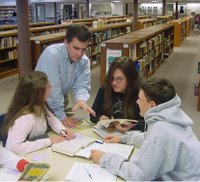Just how much do our kids know? Do we even know?
Last year in class, we were talking about A Midsummer Night's Dream and I showed my students a few clips of some high school and college productions of Shakespeare's play that I had found on YouTube. I had downloaded them and saved them on a thumb drive because our school blocks YouTube.
The kids got a kick out of seeing the humor and emotion from the scenes, something that is difficult to convey with a high school English class reading of the bard. One of the kids asked where I got the clips, and I told them I found them on YouTube.
"You go on YouTube?" one of them asked, apparently flabbergasted.
Although a little surprised that the student would think me technologically behind the times, I brushed it off as another example of the adolescent mindset - the world revolves around teenagers and adults are merely taking up space. However, I am again thinking of this exchange after seeing the results of a student technology survey by Barry that I saw, thanks to a post by Patrick. Essentially, the results seemed to reinforce some ideas I had been having an inkling about in the last several months: our students - for all the talk of digital immigrants, 21st century skills, and the wired generation - are not as digitally literate as we may think they are. Or probably more accurately, not enough has been done in schools to show students the power and potential of the Internet as a real learning tool.
Here is a highlight from Barry's survey:
Barry surveyed the students in his school. He asked them if they do any of the following on a regular basis.
Read a blog (21%)
Post comments to a blog (13%)
Write a blog (7%)
Post to a wiki ( 1%)
Listen to a Podcast (9%)
Create a podcast (2%)
Download Music (70%)
Upload music (33%)
Download photos or
video (35%)
Upload photos or video (38%)
Create videos, but don't upload
them (11%)
Text message (71%)
Send photos or videos I take with my phone (29%)
Conclusion: They text and download music. They entertain themselves with technology. I'm not sure how much content they are creating beyond their messages. Certainly the vast majority of high school students do not know how to use the Office suite for full academic potential, cite sources correctly, or access scholarly sources."
What makes this relevant is that we, as educators, assume that when we use computer technology in the class - whether it's via a spiffy PowerPoint presentation or assignments on a classroom blog - that we will suddenly flip the "on" switch for student learning. Maybe it's because that many of these web 2.0 applications come with such promise that we mistakenly assume too much.
This kind of disconnect - between student engagement and teacher technology use - can be especially sharp for teachers just getting their feet wet in the use of web 2.0 applications. The question I have for teachers, is assuming that Barry's results a generally true, what are the implications for the classroom? What do we need to do as teachers to make sure we are utilizing the proper tools and promoting the important skills? What do we have to do bridge that student technology gap? The gap between viewing and using technology as an entertainment tool and utilizing it as a learning tool? Maybe the first step is for teachers to take that same survey and see what the results would be.One final thought. I was surprised when my student had not considered any educational potential in something like YouTube. How many of the teachers in your building are likewise unaware of such educational potential? What do we need to do to fix that?







